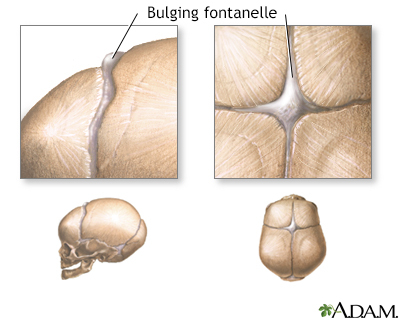Fontanelles - bulging
Definition
A bulging fontanelle is an outward curving of an infant's soft spot (fontanelle).
Alternative Names
Soft spot - bulging; Bulging fontanelles
Considerations
The skull is made up of many bones, 8 in the skull itself and 14 in the face area. They join together to form a solid, bony cavity that protects and supports the brain. The areas where the bones join together are called the sutures.
The bones are not joined together firmly at birth. This allows the head to change shape to help it pass through the birth canal. The sutures get minerals added to them over time and harden, firmly joining the skull bones together.
In an infant, the space where 2 sutures join forms a membrane-covered "soft spot" called a fontanelle (fontanel). The fontanelles allow for growth of the brain and skull during an infant's first year.
There are normally several fontanelles on a newborn's skull. They are located mainly at the top, back, and sides of the head. Like the sutures, fontanelles harden over time and become closed, solid bony areas.
- The fontanelle in the back of the head (posterior fontanelle) most often closes by the time an infant is 1 to 2 months old.
- The fontanelle at the top of the head (anterior fontanelle) most often closes between 7 to 19 months.
The fontanelles should feel firm and very slightly curved inward to the touch. A tense or bulging fontanelle occurs when fluid builds up in the brain or the brain swells, causing increased pressure inside the skull.
When the infant is crying, lying down, or vomiting, the fontanelles may look like they are bulging. However, they should return to normal when the infant is in a calm, head-up position.
Causes
Reasons a child may have bulging fontanelles include:
- Encephalitis. Swelling (inflammation) of the brain, most often due to infections.
- Hydrocephalus. A buildup of fluid inside the skull.
- Increased intracranial pressure.
- Meningitis. Infection of the membranes covering the brain.
Home Care
If the fontanelle returns to normal appearance when the child is calm and head-up, it is not a truly bulging fontanelle.
When to Contact a Medical Professional
Immediate, emergency care is needed for any infant who has a truly bulging fontanelle, especially if it occurs along with fever or excess drowsiness.
What to Expect at Your Office Visit
The health care provider will perform a physical exam and ask questions about the child's medical history, such as:
- Does the "soft spot" return to normal appearance when the infant is calm or head-up?
- Does it bulge all the time or does it come and go?
- When did you first notice this?
- Which fontanelles bulge (top of the head, back of the head, or other)?
- Are all the fontanelles bulging?
- What other symptoms are present (such as fever, irritability, or lethargy)?
Diagnostic tests that may be done are:
Gallery


References
Goyal NK. The newborn infant. In: Kliegman RM, St. Geme JW, Blum NJ, Shah SS, Tasker RC, Wilson KM, eds. Nelson Textbook of Pediatrics. 21st ed. Philadelphia, PA: Elsevier; 2020:chap 113.
Rosenberg GA. Brain edema and disorders of cerebrospinal fluid circulation. In: Jankovic J, Mazziotta JC, Pomeroy SL, Newman NJ, eds. Bradley and Daroff's Neurology in Clinical Practice. 8th ed. Philadelphia, PA: Elsevier; 2022:chap 88.
Somand DM, Meurer WJ. Central nervous system infections. In: Walls RM, Hockberger RS, Gausche-Hill M, eds. Rosen's Emergency Medicine: Concepts and Clinical Practice. 9th ed. Philadelphia, PA: Elsevier; 2018:chap 99.